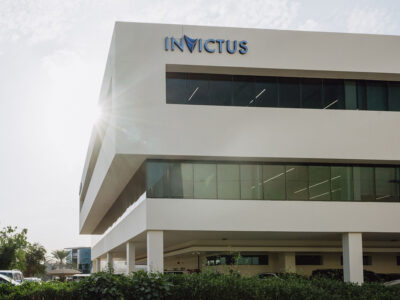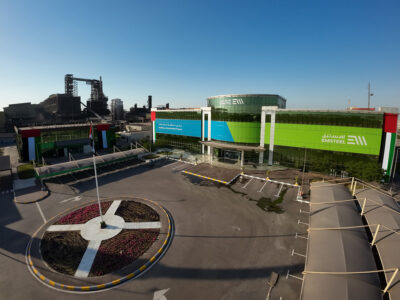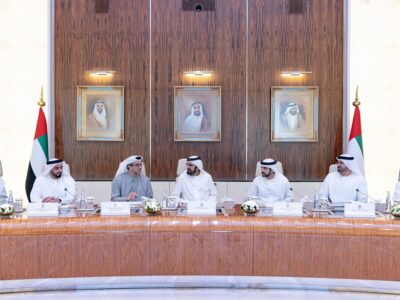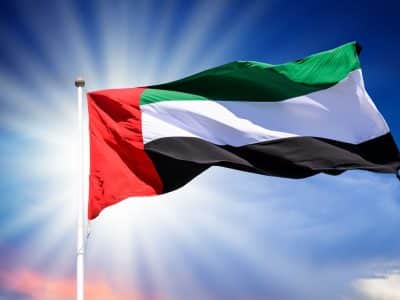Emiratis are paying millions for exceptional racing camels. Are they mere status symbols, or is there more to it? Melissa Sleiman reports from an auction.
Even before Nasi and Zafarana’s daughter was born, it was known that one day she’d be worth a lot of money. Today, not only does she carry their genes, but her slim, shapely legs attract the attention of powerful men.
‘Number 821′ is certainly no ordinary girl – actually, she is one of the 80 camels to be sold at the fourth annual camel auction in Abu Dhabi. A buyer from Dubai’s royal family will soon pay the highest amount in the history of the auction for her.
At the auction, the buyers, all Emiratis, are sitting in fancy gold and red chairs on a stage at the Abu Dhabi National Exhibition Centre. They wear their sunglasses pushed up on their heads so they can read booklets containing information about the precious lots.
In front of them, a young camel and his father, their necks tied together, stumble around in the sand area. The loud, traditional Arabic music blasting out of the speakers stops as the auctioneer starts the bidding at 20,000 dirhams (US$5400).
Camel trader Nayem bin Ali al-Ghalani (36) is among the watching crowd. Nayem – short, very tanned and dressed entirely in white – doesn’t show interest and continues talking on his mobile phone. He is waiting for a camel coming from a family with a proven track record in camel racing.
“If what I’m looking for is presented, I have an unlimited budget,” he says. Nayem explains he often buys camels, races them and then sells them on the back of wins, when their prices have accordingly risen. Exceptional racing camels are worth millions of dirhams. He refuses to share any details on the amounts of money he makes.
He also buys camels on behalf of others. Two years ago, he paid 2.5 million dirhams at auction for a camel, acting on the instruction of His Highness Sheikh Hazza’ bin Zayed al Nahyan. That camel’s father, Jabbar, had won race after race.
“His Highness’ camel is racing now, too”, says Nayem. “It always comes in first or second. The Sheikh is not willing to sell it on for any price. People admire him because he has an exceptionally good camel.”
Next to Nayim sits auction manager Khalifa Abdullah Al Nuaimi. He greets the interested buyers with a nose kiss and updates them on what is happening, and the sums of money changing hands. He also keeps track of the funds generated by the auction.
“Last year the total revenue generated was 7.7 million dirhams, approximately US$2.1 million”, he says.
“The most expensive camel cost 900,000 dirhams, which is not a lot compared to the camel sold for 2.5 million two years ago. That was the most expensive sold since we started this auction, which was the first camel auction in the world.”
The auctioneer is not nearly illiciting that sort of bidding yet. But he is certainly doing his best: “Yalla! Who can pass 100,000 dirhams!” he shouts. The camel walks another round. The buyers barely respond. They only look up when a furious camel is heard letting out a load moan, kicking the stable door.
This sale is bought to a hurried close when the arrival of Sheikh Mohammed bin Hamdan bin Zayed al Nahyan is announced. The previously bored-looking buyers now leap to their feet to greet him.
“Salaam,” His Highness responds to each of them, before taking his place on a VIP couch at the front. Immediately, he is handed a cup of Arabic coffee, while another servant places a large tray of chocolate bonbons next to him. The bidding continues as the royal Sheikh talks on his phone.
Haifa Khoory, wearing a colorfully decorated abaya is the only woman in a sea of white dishdashes. She sits in the back of the audience. The 32-year-old Emirati is doing a PhD on racing camels and their genetic make-up. Simultaeneously, she is completing a Masters degree in forensic animal science at the University of Western Australia. She agrees with camel trader Nayem that ownership of prized camels imbues social prestige.
“In the past, the Bedouin tribes looked at how many camels someone had to determine how wealthy he was,” she explains. “In the Quran, it is said that the camel is special, and that it is beneficial for its milk, which is said to have medicinal qualities. The camel is known as the ‘sheep of the desert.’ A good camel was a very valuable asset. We are still holding on to that culture.”
According to Haifa, camel racing has been practised for generations, but its popularity increased markedly during the past decade because of the enthusiasm for it of the late Sheikh Zayed bin Sultan al Nahyan, ruler of Abu Dhabi and President of the UAE until his death in 2004.
“He increased the prize money for the races at Al-Wathba track and helped to ensure that the events were more organised,” she says.
This was the first step towards getting a broader audience interested in keeping racing camels, says Haifa. “It started out being a hobby of the royal families in the UAE. Now, more people are starting to do it. But they have to be rich. It’s very costly to train the animals.”
Diet and training schedules are crucial in creating a champion camel. “Regimes are closely guarded secrets passed on from generation to generation of experts, usually in service of a royal family,” Haifa explains.They know exactly how to deal with the stress the camels endure while racing and the joint problems they often get.
As good as the training programme is, however, it is academic unless racing blood courses through the animal’s veins. As in equine racing, genes and bloodstock are everything.
Dr. Irfan Ahmed of the Veterinary Research Centre (VRC) in Sweihan, a reproduction centre which has overseen the conception of all camels being auctioned today, is present to watch the sales taking place. He is wearing a white lab coat and busily informing potential buyers about the available camels’ origins.
The VRC was established in 1990, sponsored by UAE President Sheikh Zayed bin Sultan al Nahyan and his two sons, Sheikh Hamdan and Sheikh Hazza’. Using the latest embryo implantation procedures, the centre induces camels to give birth up to twenty times a year. Normally, camels will give birth once every two years.
“We see which locally bred camels have given good racing results and then we try to breed the maximum number from them,” explains Dr. Irfan. “We get the best female and best male and put the embryo in an ordinary camel’s womb. But we can’t yet tell from the start which ones will be exceptional.”
This year, the experts at the centre have overseen 300 births thanks to the program. Since 1991, 2500 camels have been bred.
Typically, they are sold between the ages of 18 months and two years at auction. The new owner then has plenty of time to train the camel. It won’t compete in its first race until up to a year later.
Meanwhile, the auctioneer is cooercing the audience into bidding. A camel is sold for 120,000 dirhams. “Congratulations to the buyer,” the auctioneer shouts. “Stand up and let us see who you are!” On his feet, the buyer smiles faintly while the audience claps and turns to look at him.
Nayem has now entered the market, too. “What kind of camels do I bid on? That depends on its origin, the way it looks and walks.” Haifa adds: “You need to look at the length of the legs and if the neck is long. Those are the main characteristics of fast runners.”
But it’s far from a racing certainty that a camel from a good family will do well in competition, says Hamed Azzan al-Mazrouie (58), who is sitting in the front row at the auction. He is smoking an Arabic pipe cigarette and wearing a red headdress. A silver pot containing food is on the table in front of him.
“It’s happened that some of my camels did not do well in any race,” he says cheerfully. “Out of the five camels I’d buy, one or two will not perform the way I expected them to. It sometimes depends on luck. If a male camel is hopeless, I sell it. If it’s female, I can get it pregnant by a good male.”
Although this year al-Mazrouie’s budget is around 700,000 dirhams, he is not one of the big spenders. Usually he buys around five camels for 70,000 dirhams per animal. Last year, he spent 450,000 dirhams.
He takes out his booklet in which the available camels are listed. “I’m waiting to see the children of Taiare,” he says and points at her picture. “She is a winner.” He looks at the pictures of other camels.
“This one I want, I have his brother. He’s performing great. I’m hoping the other kid will be the same.” Then, enthusiastically: “This is one of the best camels. Jabbar, Jabbar, Jabbar! He is great.”
Towards the end of the auction, UAE Minister of Interior His Highness Sheikh Saif bin Zayed al Nahyan, arrives. A black and gold mantle covers his dishdash.
An entourage of around twenty people follows him wherever he goes. A group of press photographers adds to the scene. “Now the bidding will go up, because he is watching,” whispers someone in the audience to his friend.
The auction staff finally bring out ‘number 821′, the daughter of Nasi and Zafarana. A hush falls over the crowd. Only recently, her sister won the Champion of Champions stakes at Al Marmoum racing track in Dubai.
“After that race, she was immediately sold by the owner to Dubai Sheikh Hamdan bin Mohammed bin Rashid Al Maktoum for a few million dirhams,” Dr. Irfan murmurs.
“We’re expecting millions for this one,” he adds excitedly, as buyers aggressively raise their bidding paddles one after another. “I heard people talking. Some said they are willing to spend up to five million.”
“Six million dirhams!” yells the auctioneer moments later and smashes his gavel on the table. “A record in the history of the camel auction!” The proud owner? Sheikh Hamdan bin Mohammed bin Rashid Al Maktoum. The audience stands and applauds enthusiastically.
At the end of the two-day auction, total sales amounted to fourteen million dirhams. Much of the money will be invested into camel research at the VRC.
Nasi and Zafarana’s daughter is now officially the most expensive camel ever sold at public auction. Whether she was worth the money will be made clear soon enough on the racetrack. For the time being, the extraordinary high price paid for her is prestige enough.







